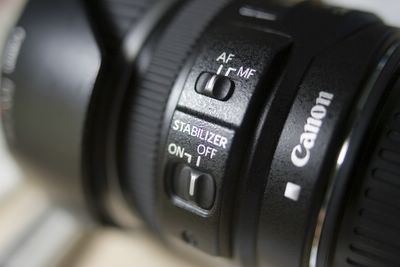Canon與Nikon鏡頭說明:
本文討論 Canon 鏡頭之標記方法:
例如 EF400mm f/4 DO IS USM
EF:為 Canon 放棄手動 FD 接環以後,新發展之接環,其電子接點可與機身傳遞對焦、光圈、快門等資料。
400mm:鏡頭之焦距,單一數字表示為定焦鏡,如有 28-70 等表示為變焦鏡 。
f/4:鏡頭之最大光圈,如為單一數字表示恆定光圈,如有 3.5-5.6 表示廣角端最大光圈 3.5,望遠端最大光圈5.6 。
DO:Diffractive Optical,為 canon 新發展之技術,其主要用在長焦段光圈鏡頭上,用以減輕重量及體積 。
IS:Image Stabilizer,用於當鏡頭震動時,鏡頭內之鏡片可以移動、矯正影像,而不至於因手振而得到模糊之影像 。
USM:Ultrasonic Motor,超音波馬達,可實踐安靜無聲之快速對焦,又可分成環形USM、內對焦式USM等多種 。
UD:Ultra-low Dispersion,超低色散鏡片 。
TS-E:又可分 Tilt 及 Shift 兩種,通常專門用來拍攝建築物,矯正其筒狀變形 。
Macro:微距鏡頭 。
Nikon鏡頭之標記方法:
例:
AF-S Zoom Nikkor ED 17∼35mm F2.8D(IF)
AF Zoom Nikkor 24∼85mm F2.8∼4D(IF)
AF-S VR Zoom Nikkor ED 70∼200mm F2.8G(IF)
AF-S DX Zoom Nikkor ED 17∼55mmF2.8G(IF)
Ai Nikkor 35mm F1.4S
PC Micro Nikkor 85mm F2.8D
D : 代表鏡頭可回傳對焦距離資訊,作為 3D 矩陣測光的參考以及 TTL 閃燈距離的運算!!
S : 可支援自動測光相機的鏡頭!!
G : 為 NIKON F MOUNT 接環鏡頭,但無光圈環設計,光圈調整必須有機身來調整, 可支援的機身只有新世代的機身,F5 ; F100 ; F80 ; F65 ; F60 ; F55 ; D1 ; D1X ; D1H ; D100, 在F90X之前發表的自動機身(含F90X)只支援P MODE(程式自控)及S MODE(快門優先)!!
Macro : 是指這顆鏡頭是微距鏡,或有微距的功能!!
IF : 是內對焦,在對焦時,前後組鏡片都不移動,鏡長不變!!
AF-S : 有AF-S 的鏡頭,代表這支鏡頭是由Silent Wave Motor 對焦,俗稱超音波馬達, 不是由機身馬達對焦,優點是對焦速度快,可全時手動對焦,缺點是重量不輕,價格不低, 可支援AF-S 鏡頭自動對焦的相機有 F5 ; F4 ; F100 ; F90X ; F90 ; F80 ; F70 ; F65 ; D1 ; D1X ; D1H ; D100,其餘的機身可以接,也可以測光但不能自動對焦!!
ED : Extra-low Dispersion的縮寫,是指這支鏡頭內含 ED 鏡片,ED 鏡為超低色散鏡片, 使影像不會有色散的現象!!
VR : Vibration Reduction 的縮寫,為NIKON的防手震鏡頭的代號,可用於手持攝影在低速快門時,增加畫面的穩定性,不會因為手震而模糊掉,能支援VR的機身有 F5 ; F100 ;F80 ; F65 ; D1 ; D1X ; D1H ; D100,其餘機身可以使用鏡頭但不支援VR功能!!
DC : Defocus-image Control 的縮寫,可作影像主體的前景或後景的柔焦,在鏡頭上多一圈控制柔焦程度的轉環,是光學柔焦,非一般市售柔焦鏡片所能作出的效果!!
RF : Rear Focusing 的縮寫,為後對焦鏡頭,與IF不同的是RF鏡頭對焦時.後組鏡片會移
動,但鏡頭長度一樣不變!!
CRC : Close-Range Correction ,是用於廣角鏡的桶狀變型修正的結構!!
Aspherical Lens : 鏡頭上刻有Aspherical Lens.是該鏡頭有使用非球面鏡片!!
"s" 是AIS鏡頭-- 1987年後出產的Nikon手動鏡頭,最少光圈值是橙色的。主要是為了FA 及以後機種在P mode時分別鏡頭焦距用的。(Longer focal length, higher shutter speed)
DX : Nikon專門為自家D-SLR所設計的鏡頭,只能使用於D-SLR上,用於一般傳統相機會有"成像圈",DX鏡頭是為了解決DSLR 1.5倍視角,所衍生出的無廣角端鏡頭可用的解決方案.
PC : 表示這顆鏡頭是移軸鏡頭.
先說小白和小小白
小白是 EF 70-200mm F2.8L
小小白是 EF 70-200mm F4L
還有小白IS
就是EF 70-200mm F2.8L IS,多了防手震的功能.
大三元就是三支F2.8橫定光圈變焦鏡的組合.
EF 16-35mm F2.8L
EF 24-70mm F2.8L
EF70-200mm F2.8L IS
也可以套用在Nikon上.
AF-S 17-35mm F2.8D ED
AF-S 28-70mm F2.8D ED
AF-S VR 70-200mm F2.8G ED
小三元應該是只
EF 17-40mm F4L
EF 28-70mm F2.8L ?(不確定)
EF 70-200mm F4L
Nikon的小三元
AF 18-35mm F3.5-4.5D ED
AF 35-70mm F2.8D
AF 80-200mm F2.8D ED



































